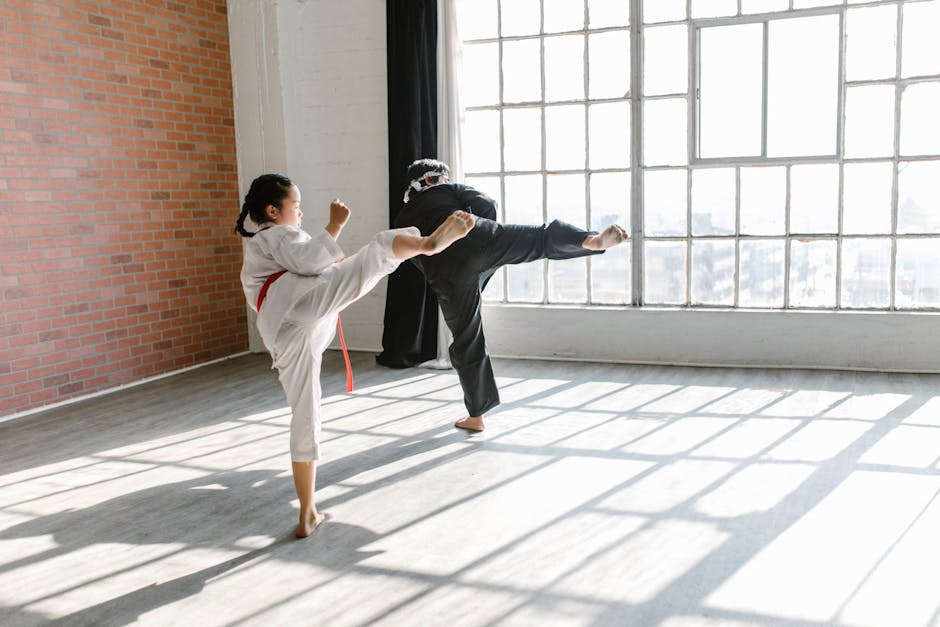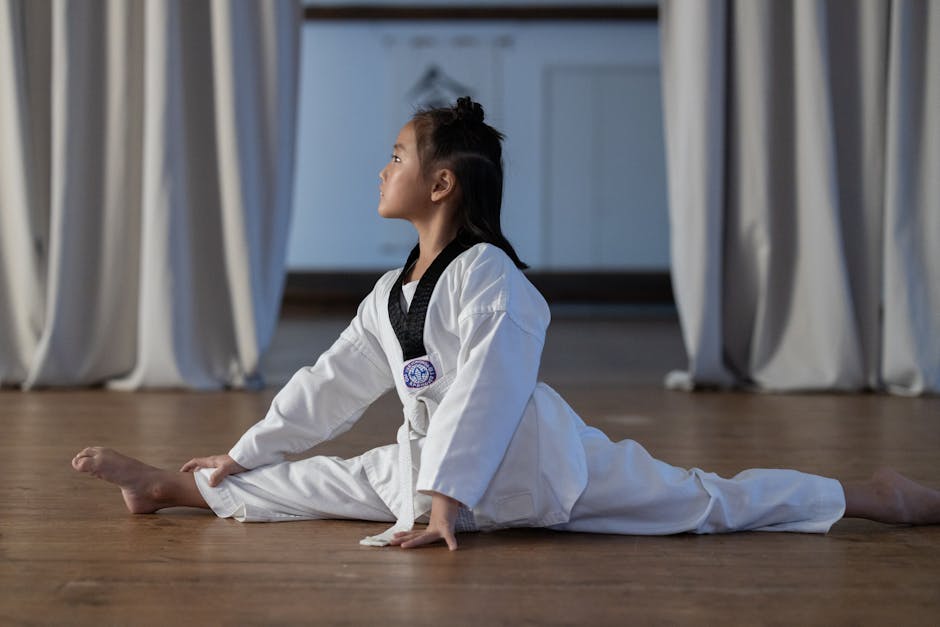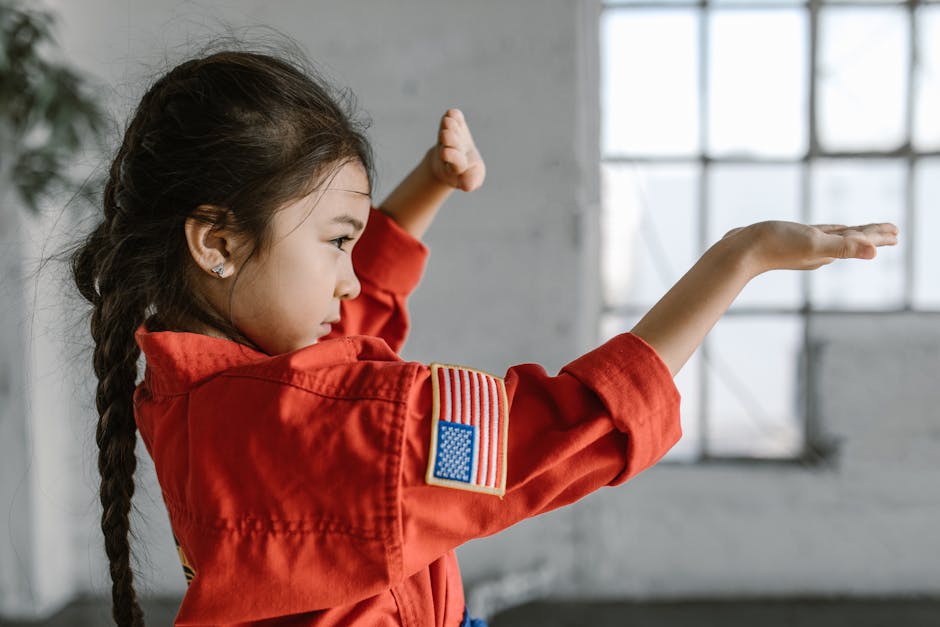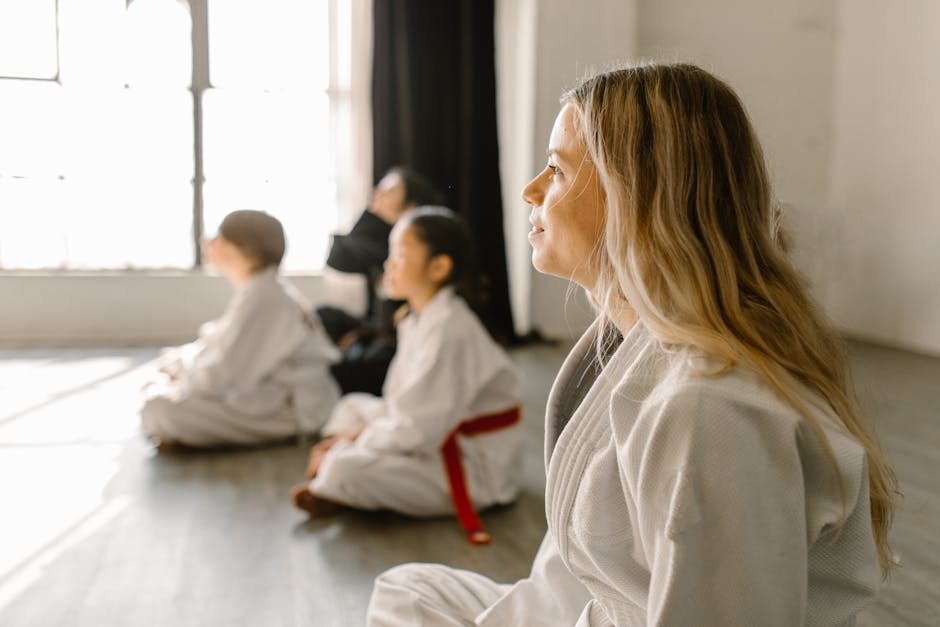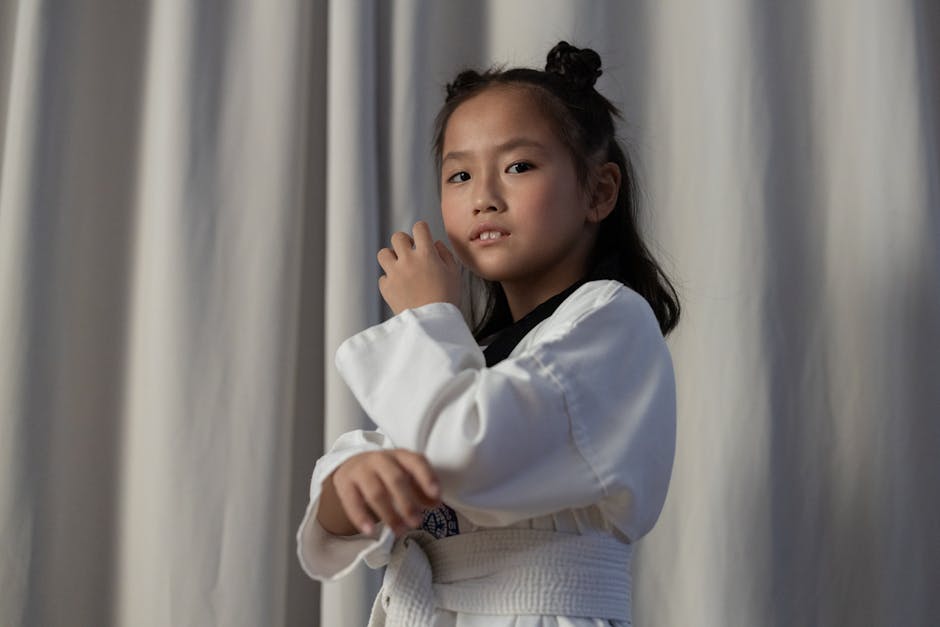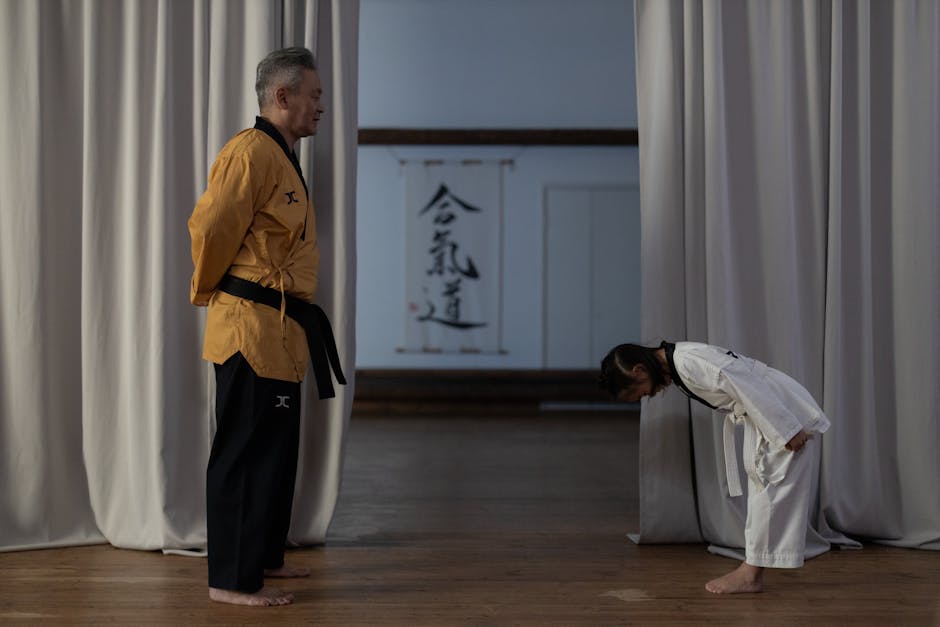Table of Contents
Black Belt Poomsae
As we learned before, not every style of Taekwondo is for everyone. Some styles are particular and require lots of practice to achieve success. This is particularly true in some styles that focus more on looks than practical self-defence!
With this being said, one particular type of Taekwondo can be described as “self-defence” or “martial arts” techniques for everything from kicking bags to blocking knife attacks.
This style is called poomsae (POOM SAH), and Buddhist monks initially developed it. Since then, many different cultures have adapted and incorporated poomsae into their culture and folklore.
You probably know a few yourself! Many famous stories feature characters using poomsae to defend themselves or help others in battle.
These include The Legend of Zelda series, where Link uses his signature sword against the villain, Ormus; Katniss Everdeen, where she uses her bow and arrow to take down an angry crowd; and Harry Potter, where Professor Dumbledore teaches students how to use various types of magic to protect themselves.
The list goes on and on!
So what makes poomsae so unique? Why should we learn this technique if most other martial art forms aren’t designed to fight or defend ourselves against violence directly?
Fortunately, there are some great reasons! Here are three: cost-effectiveness, ease of use, and versatility.
What are poomsae?
Photo by RODNAE Productions on Pexels
A poomsae or pumse in Korean is typically translated as “fighting style,” but that isn’t quite right. A poomsae is not just an aggressive technique used for attacking or defending against another person; it can also be called a skill or art.
A poomsae is usually categorized into one of five types: krong-gyeng (empty hand), ganghu (fist), pugui (staff or sjanggun), taechak (hooks or wire arm) and dokka (knife). These terms don’t specify what kind of weapon the move is applied to, only the type. For example, a poomsae called jeokdohye uses your feet as weapons!
There are many different ways to apply these poomsae to various situations, so you don’t have to use them all! Knowing how to do at least one is excellent because they add some flavour to your martial arts practice. Learning how to defend with your hands, fist, staff, hook, or knife gives you more options.
Examples of poomsae
Photo by cottonbro studio on Pexels
Poomsae is a term that refers to a style or type of hand-to-hand combat practised by some martial arts. In general, poomsae are styles or moves designed to be performed against a larger opponent or as self-defence strategies.
There are three main types of poomsae: kyusho (self-defence), gatka (anti-weapon) and berserker (wild rage). Kyusho poomsae focus more on striking techniques, while anti-weapons poomsae use tools like knives or guns to defeat the enemy.
Berserkers typically practice Taekwondo but add different elbow strikes and kneeing to achieve their goal — destruction!
There are many variations of each poomsae style, which create new terms such as ‘kumdo’ (hook punch) for the kyusyo version and ‘bulgogi roll’ for the gatka. This means infinite ways to combine movements and concepts into something unique!
This article will go through several examples of each poomsae style and how they can be applied to everyday life.
Koryo
Koryo is the name of one of the poomsae (also spelt pumsae or poomse) in the traditional taekwondo curriculum. Poomsae are predetermined sequences of taekwondo techniques performed alone as a form of training and development. Koryo is the first black belt poomsae named after the Korean Goryeo Dynasty, which ruled from the 10th to the 14th centuries. The movements in the Koryo poomsae are based on the fluid and dynamic techniques of the Goryeo period martial artists. The poomsae consists of a series of kicks, punches, blocks, and stances and is typically performed by students who have achieved a black belt rank.
World Taekwondo, formerly known as the World Taekwondo Federation (WTF), is the international federation for Taekwondo and is responsible for organizing and promoting the sport of Taekwondo around the world. World Taekwondo sets the rules and regulations for competitions and sponsors international tournaments, including the World Taekwondo Championships and the Olympic Games. The Koryo poomsae is recognized and practised by World Taekwondo and several other poomsae that are part of the traditional taekwondo curriculum.
Keumgang
Keumgang is the name of one of the poomsae (also spelt pumsae or poomse) in the traditional taekwondo curriculum. Poomsae are predetermined sequences of taekwondo techniques performed alone as a form of training and development. Keumgang is the second black belt poomsae named after Korea’s diamond mountain (Keumgang). The movements in the Keumgang poomsae are based on the hardness and clarity of the diamond and are intended to represent the indomitable spirit of the martial artist. The poomsae consists of a series of kicks, punches, blocks, and stances and is typically performed by students who have achieved a black belt rank.
World Taekwondo, formerly known as the World Taekwondo Federation (WTF), is the international federation for Taekwondo and is responsible for organizing and promoting the sport of Taekwondo around the world. World Taekwondo sets the rules and regulations for competitions and sponsors international tournaments, including the World Taekwondo Championships and the Olympic Games. The Keumgang poomsae is recognized and practised by World Taekwondo and several other poomsae that are part of the traditional taekwondo curriculum.
Taebaek
Taebaek is the name of one of the poomsae (also spelt pumsae or poomse) in the traditional taekwondo curriculum. Poomsae are predetermined sequences of taekwondo techniques performed alone as a form of training and development. Taebaek is the third black belt poomsae named after the Taebaek mountain range in Korea. The movements in the Taebaek poomsae are based on the strength and stability of the mountains and are intended to represent the power and solidity of the martial artist. The poomsae consists of a series of kicks, punches, blocks, and stances and is typically performed by students who have achieved a black belt rank.
Pyongwon
Pyongwon is the name of one of the poomsae (also spelt pumsae or poomse) in the traditional taekwondo curriculum. Poomsae are predetermined sequences of taekwondo techniques performed alone as a form of training and development. Pyongwon is the fourth black belt poomsae and is named after Korea’s “plain of peace” (Pyongwon). The movements in the Pyongwon poomsae are based on the vastness and openness of the plain and are intended to represent the martial artist’s readiness for any challenge. The poomsae consists of a series of kicks, punches, blocks, and stances and is typically performed by students who have achieved a black belt rank.
World Taekwondo, formerly known as the World Taekwondo Federation (WTF), is the international federation for Taekwondo and is responsible for organizing and promoting the sport of Taekwondo around the world. World Taekwondo sets the rules and regulations for competitions and sponsors international tournaments, including the World Taekwondo Championships and the Olympic Games. The Pyongwon poomsae is recognized and practised by World Taekwondo and several other poomsae that are part of traditional Taekwondo.
Sipjin
Sipjin is the name of one of the poomsae (also spelt pumsae or poomse) in the traditional taekwondo curriculum. Poomsae are predetermined sequences of taekwondo techniques performed alone as a form of training and development. Sipjin is the fifth of the black belt poomsae and is named after the “ten stars” (Sipjin) in the Korean constellation. The movements in the Sipjin poomsae are based on the ten celestial stems and twelve earthly branches of the East Asian zodiac. They represent the martial artist’s enduring spirit and timeless wisdom. The poomsae consists of a series of kicks, punches, blocks, and stances and is typically performed by students who have achieved a black belt rank.
World Taekwondo, formerly known as the World Taekwondo Federation (WTF), is the international federation for Taekwondo and is responsible for organizing and promoting the sport of Taekwondo around the world. World Taekwondo sets the rules and regulations for competitions and sponsors international tournaments, including the World Taekwondo Championships and the Olympic Games. The Sipjin poomsae is recognized and practised by World Taekwondo, along.
Jitae
Jitae is the name of one of the poomsae (also spelt pumsae or poomse) in the traditional taekwondo curriculum. Poomsae are predetermined sequences of taekwondo techniques performed alone as a form of training and development. The poomsae consists of a series of kicks, punches, blocks, and stances and is typically performed by students who have achieved a black belt rank. Jitae is the sixth of the black belt poomsae and is named after the “seven stars” (Jitae) in the Korean constellation. The movements in the Jitae poomsae are based on the seven celestial stems and eight earthly branches of the East Asian zodiac. They are intended to represent the martial artist’s nobility and honour.
World Taekwondo, formerly known as the World Taekwondo Federation (WTF), is the international federation for Taekwondo and is responsible for organizing and promoting the sport of Taekwondo around the world. World Taekwondo sets the rules and regulations for competitions and sponsors international tournaments, including the World Taekwondo Championships and the Olympic Games. The Jitae poomsae is recognized and practised by World Taekwondo and several other poomsae that are part of the traditional taekwondo curriculum.
Chonkwon
Chonkwon is the name of one of the poomsae (also spelt pumsae or poomse) in the traditional taekwondo curriculum. Poomsae are predetermined sequences of taekwondo techniques performed alone as a form of training and development. The poomsae consists of a series of kicks, punches, blocks, and stances and is typically performed by students who have achieved a black belt rank. Chonkwon is the seventh black belt poomsae named after Korea’s “heavenly lake” (Chonkwon). The movements in the Chonkwon poomsae are based on the fluid and graceful movements of water and are intended to represent the martial artist’s fluidity and adaptability.
World Taekwondo, formerly known as the World Taekwondo Federation (WTF), is the international federation for Taekwondo and is responsible for organizing and promoting the sport of Taekwondo around the world. World Taekwondo sets the rules and regulations for competitions and sponsors international tournaments, including the World Taekwondo Championships and the Olympic Games. The Chonkwon poomsae is recognized and practised by World Taekwondo, along with several other poomsae that are part of the traditional taekwondo curriculum.
Hansu
Hansu is the eighth black belt poomsae named after the “water” (Hansu) in the Korean language. Hansu is the name of one of the poomsae (also spelt pumsae or poomse) in the traditional taekwondo curriculum. Poomsae are predetermined sequences of taekwondo techniques performed alone as a form of training and development. The poomsae consists of a series of kicks, punches, blocks, and stances and is typically performed by students who have achieved a black belt rank. The movements in the Hansu poomsae are based on water’s fluid and flexible nature and represent the martial artist’s adaptability and versatility.
World Taekwondo, formerly known as the World Taekwondo Federation (WTF), is the international federation for Taekwondo and is responsible for organizing and promoting the sport of Taekwondo around the world. World Taekwondo sets the rules and regulations for competitions and sponsors international tournaments, including the World Taekwondo Championships and the Olympic Games. The Hansu poomsae is recognized and practised by World Taekwondo and several other poomsae that are part of the traditional taekwondo curriculum.
Ilyeo
Ilyeo is the name of one of the poomsae (also spelt pumsae or poomse) in the traditional taekwondo curriculum. Poomsae are predetermined sequences of taekwondo techniques performed alone as a form of training and development. Ilyeo is the ninth black belt poomsae and is named after the “one” (Ilyeo) in the Korean language. The movements in the Ilyeo poomsae are based on the unity and wholeness of the martial artist and are intended to represent the martial artist’s indivisibility and completeness. The poomsae consists of a series of kicks, punches, blocks, and stances and is typically performed by students who have achieved a black belt rank.
World Taekwondo, formerly known as the World Taekwondo Federation (WTF), is the international federation for Taekwondo and is responsible for organizing and promoting the sport of Taekwondo around the world. World Taekwondo sets the rules and regulations for competitions and sponsors international tournaments, including the World Taekwondo Championships and the Olympic Games. The Ilyeo poomsae is recognized and practised by World Taekwondo and several other poomsae that are part of the traditional taekwondo curriculum.
Touchpoints in poomsae
Photo by RODNAE Productions on Pexels
A touchpoint is an action or event that sparks your engagement, interest, or perception of a product or service.
Many companies use touchpoints to promote their products and services. For example, if you read this article, Amazon has successfully lured you into viewing or buying something from them.
The advertisements, marketing materials, and direct messages they include are all part of their touchpoint strategy.
Touchpoints can be internal (within a company) or external (beyond its boundaries). Internal touchpoints are ones the company creates for themselves, like using the same coffee shop every morning for work or having lunch together as a team once per week.
External touchpoints are outside the company’s control, like advertising others’ products or services that inspire an idea or connection.
This article will discuss some dos and don’ts of incorporating poomsae into your bokum to create engaging touch points.
Benefits of poomsae
Photo by RODNAE Productions on Pexels
One of the essential things about poomsae is that it helps you to understand yourself. By practising poomsae, you learn how to identify your strengths and weaknesses as a person and what types of movements feel good for you.
Your sense of self-confidence can improve due to poomsae training. Not only do you work on specific moves, but you also use the art of movement to strengthen your mind-body connection.
You’ll find that once you get into the rhythm of poomsae, you’re more motivated than before. Because you enjoy moving, you’ll keep moving at a faster pace, which aids in weight loss.
Poomsae can also help you connect with others. When you move together, you form an external bond that comes from within.
There are many styles of poomsae, so no one approach is better.
Do poomsae work?
Many martial artists believe that poomsae are useless or even harmful. These include karate, Tang-dou (Chinese stick boxing) practitioners, some Shotokan style masters, etc.
Some claim that they only serve to distract students and make them more nervous in a situation where we want them to be calm and confident.
Furthermore, many feel that practising poomsae is unnecessary as many practical self-defence tools are already available. Some of these include: running away, blocking/parrying, throwing objects, striking with hands and feet, protecting yourself from grabs, and knee strikes.
What is a kata?
Photo by cottonbro studio on Pexels
A poomsae (or poem) is a set of movements or exercises that come in a pattern. Almost every martial art has at least one poomsae, or “form”, with a unique sequence of moves. These are called katas, which means “patterns” in Japanese.
A black belt in any style will know most of its forms by heart! That’s why learning new techniques are essential – you can use them for self-defence, fitness training, or just because you like moving around and being active.
Some people even say that learning a new form is an effective way to boost your workout motivation, as you’ll always have a new challenge to work on.
What is a kancho?
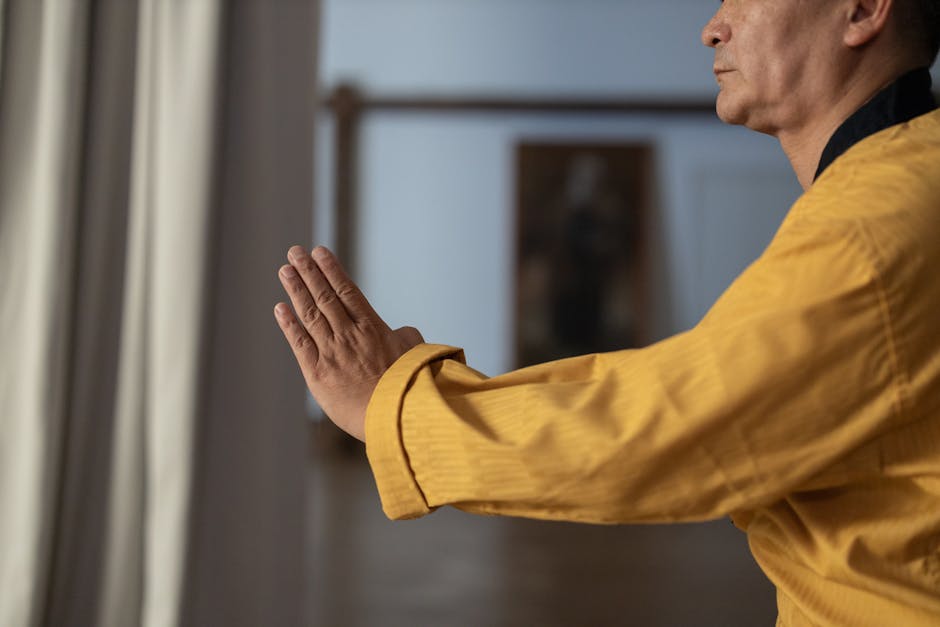
A poomsae or pumse (as it’s often called in English) is a technique or move of self-defence. Many martial arts include at least one poomsae as part of their curriculum. Some even have several!
A few basic examples of poomsae are The front kick, the back fist, the roundhouse punch, the hook punch, the jab, the shoulder throw, the elbow drop, the knee strike, and many more.
The difference between a poomsae and other techniques found in most martial art styles is that a poomsae can be done at any level — from beginner to advanced.
There are three reasons why this is important to know.
First, some poomsae may only be usable at the black belt stage. If they do work for you, then you can use them! As you gain experience, you will understand if this works or not.
Second, there are certain poomsae which are considered too powerful to teach to beginners. These poomsae should be left later when students reach an appropriate level.
Who was Bruce Lee?
Photo by cottonbro studio on Pexels
Born in 1922, Bruce Li Park Chan (as he later changed his name) grew up in Seattle as the youngest of three children. His father worked hard to provide for the family, ensuring that all three kids received a good education.
Bruce studied karate under Seigo Yamada at 12, which set him on the path to becoming one of the world’s greatest martial artists. He would create his style, Jeet Kune Do, a combined system of many different styles, including Japanese Karate, Western Boxing, and Indian Martial Arts.
He made his screen debut in 1964’s “Enter The Dragon,” before going on to star in several other action films, such as 1973’s “The Game Of Death.”
But his work outside of film has left the most legacy. Between 1965 and 1975, he appeared in over twenty TV shows, each showcasing his unique fighting style. These include programs like “Kung Fu,” “Gangsters And Goliaths,” and even “How To Make A Dragon Out Of You!”
His popularity continued well after he died in 2003. Many still refer to his techniques today, with YouTube full of students trying out new moves or copying and improving them.
🌍 Explore Our Taekwondo4Fitness Global Shop 🛍️
For more information, visit Taekwondo4Fitness. Please check my boards on Pinterest or my YouTube channel as well as the link here for additional resources. To return to the home section, click home.


